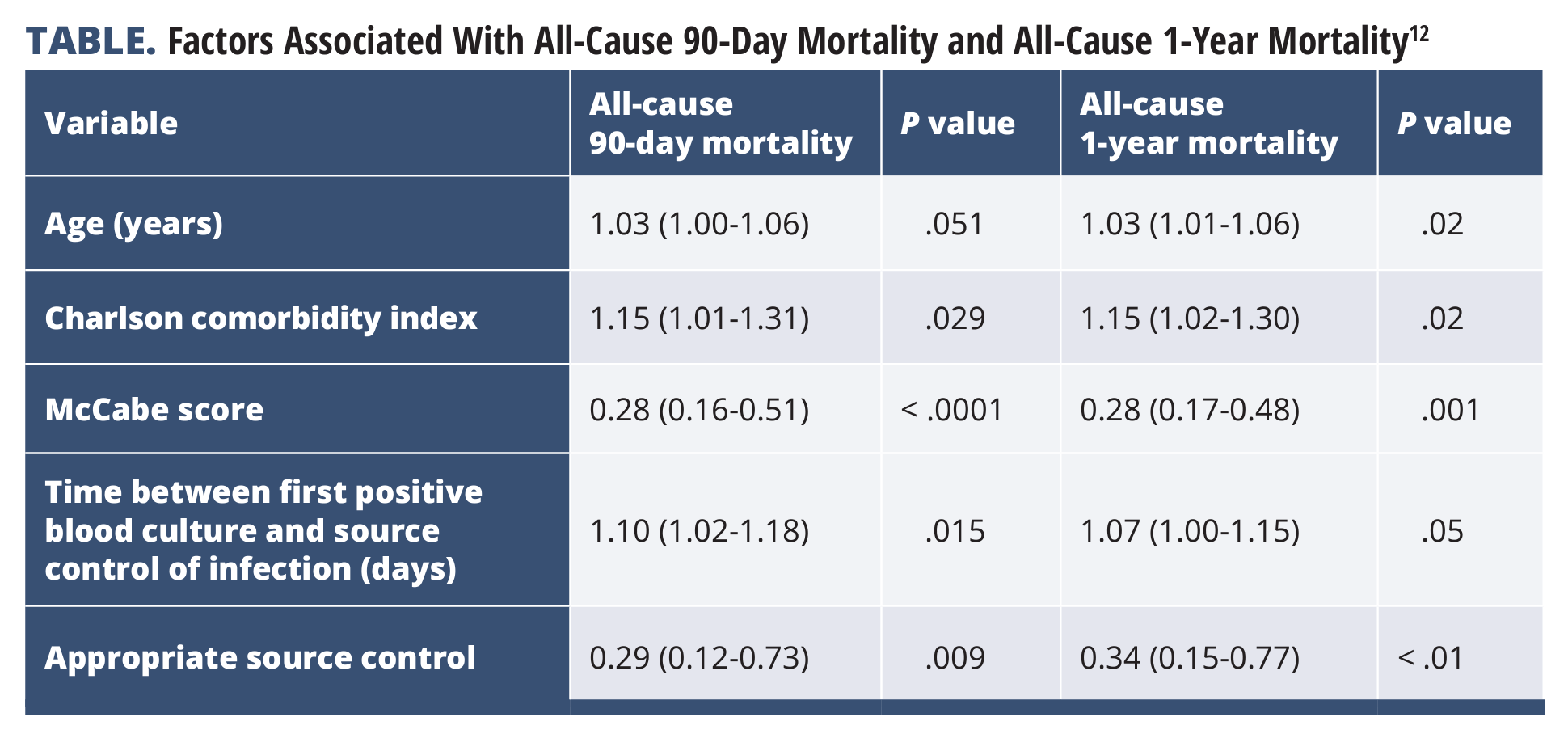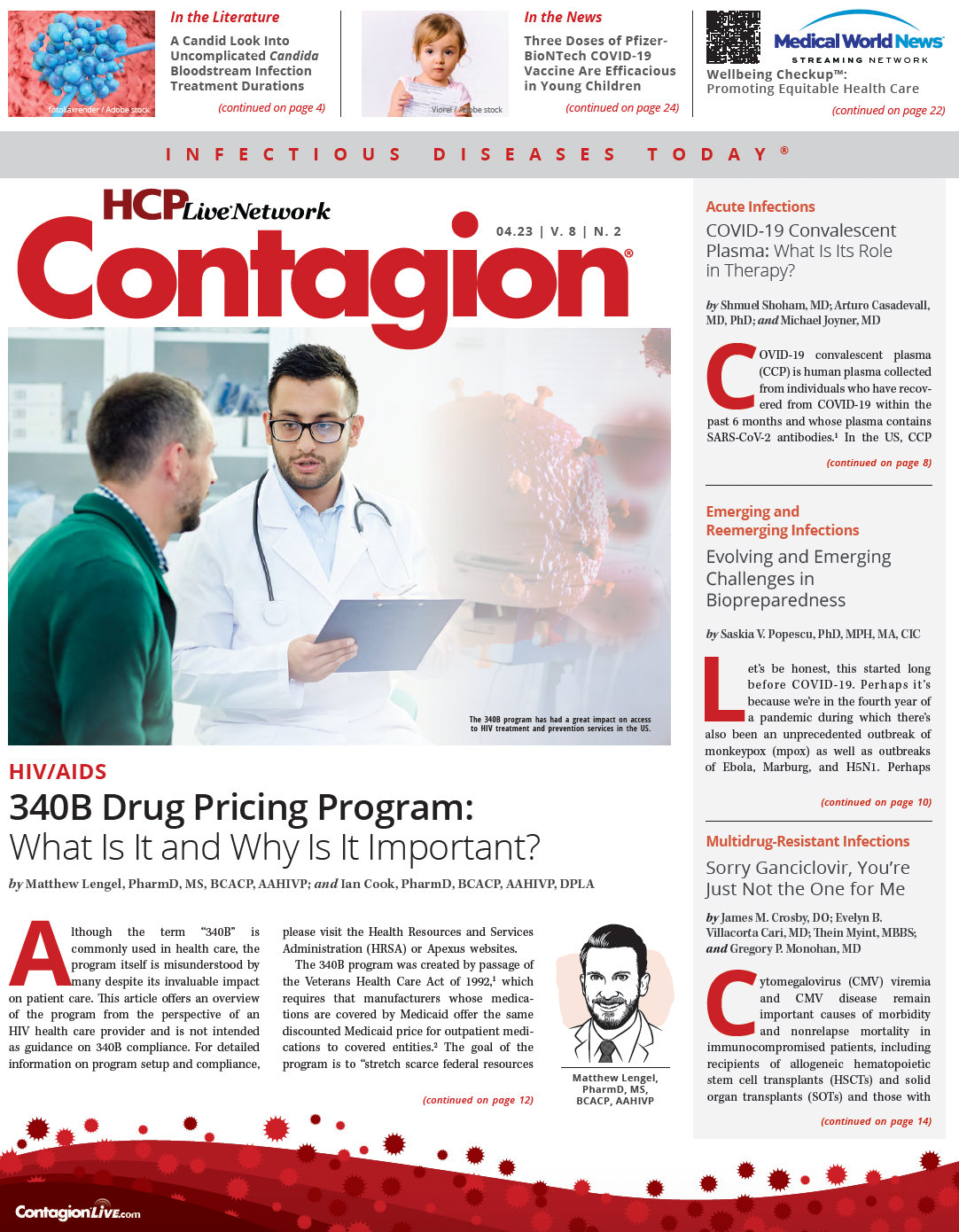A Candid Look Into Uncomplicated Candida Bloodstream Infection Treatment Durations
Antimicrobial duration of therapy has been an area of debate in many infectious disease states throughout the years. Due to the rising threat of antimicrobial resistance worldwide, efforts to address unnecessary antimicrobial exposure have increased.1
Besides preventing the emergence of resistance, shortening durations of therapy can decrease antimicrobial adverse effects and reduce hospital stay and health care costs.2 Retrospective studies have identified no difference in outcomes with shorter duration of therapy for uncomplicated gram-negative and gram-positive bacterial blood stream infections (BSI).3,4
Yahav et al concluded that in patients hospitalized with gram-negative bacteremia, an antibiotic course of 7 days was noninferior to one of 14 days. These results have led to shorter durations of therapy for patients with uncomplicated gram-negative bacteremia.
Candidemia is the most common cause of fungal BSI in hospitalized patients and ranks fourth as a cause of hospital-acquired BSI in the United States.5,6 Recent national guidelines recommend a minimum of 14 days of antifungal therapy after first negative blood cultures as standard of care for patients with candidemia without metastatic complications.7 This recommendation was made based on the results of older prospective, randomized trials that did not include shorter treatment courses in patients with persistent candidemia.8-11
To better understand the effect of short durations of therapy in patients with candidemia, Vena et al performed a retrospective cohort study comparing the clinical outcomes of patients receiving a short course versus a prolonged course of antifungal therapy for uncomplicated Candida bloodstream infection. Short course was defined as 5 to 11 days and prolonged course as 12 to 24 days. Adult patients with uncomplicated Candida BSI were included.
Notable exclusion criteria were clinically evident metastatic infection or deep-seated infection, complicated polymicrobial BSI, failure to receive in vitro active therapy against the Candida isolate and follow-up blood cultures every 48 hours, and death while receiving antifungal therapy for Candida BSI.
The primary end point was all-cause mortality within 90 days after discontinuation of antifungal therapy. Secondary outcomes after following patients up to 1 year included recurrent Candida BSI and all-cause 1-year mortality.
A total of 114 patients were included: 35 (30.7%) in the short-course group and 79 (69.3%) in the prolonged-course group. Nighty-day all-cause mortality occurred in 26/114 patients (22.8%): 8/35 (22.9%) in the short-course arm and 18/79 (22.8%) in the prolonged-course arm.12 Univariable (HR, 1.00; 95% CI, 0.43-2.30; P = .997) and multivariable analysis (HR, 0.47; 95% CI, 0.14-1.55; P = .22) did not associate lower or increased probability of 90-day mortality with prolonged compared to shortened courses of therapy.
Recurrent Candida BSI within 1 year of therapy occurred in 3/35 (8.6%) of the short-course group and 5/79 (6.6%) in the prolonged-course group. After adjusting for baseline confounders, a longer course of therapy did not show reduction of the risk of recurrent infection (IPTWadjusted HR, 1.07; 95% CI, 0.20-5.80; P = .940).12
No statistical significance was observed between the primary and secondary study objectives. When comparing factors associated with all-cause mortality and recurrent Candida BSI, time between first positive blood culture and source control of the infection, and appropriate source control had a noted significance with both 90-day and 1-year mortality rates (TABLE).12

The study’s retrospective design could have led to certain confounding variables being associated with clinical outcomes left unaccounted for during the multivariate analysis. In addition, only uncomplicated candidemia patients were included, leaving out approximately 75% of the original cohort and thus limiting generalizability.
The study also did not monitor adverse effects, resulting in a lack of safety considerations. It was conducted at a large teaching institution in northern Italy, with all patients followed via chart review. If patients received follow-up treatment or had recurrence at another institution, investigators had no knowledge of it.
Despite these limitations, the study concluded that short-course antifungal therapy for uncomplicated candidemia yielded similar outcomes as prolonged course therapy in terms of 90-day mortality, which serves as the basis for larger prospective trials.
This is one of the first retrospective studies to analyze the influence of length of antifungal treatment on short- and longterm outcomes in patients with uncomplicated candidemia. Given the well-known risk factors of prolonged antimicrobial therapy, future studies examining a shorter duration of therapy for uncomplicated candidemia may provide valuable insight into potential changes in practice.
References
- Llor C, Bjerrum L. Antimicrobial resistance: risk associated with antibiotic overuse and initiatives to reduce the problem. Ther Adv Drug Saf. 2014;5(6):229-241. doi:10.1177/2042098614554919
- Tamma PD, Avdic E, Li DX, Dzintars K, Cosgrove SE. Association of adverse events with antibiotic use in hospitalized patients. JAMA Intern Med. 2017;177(9):1308-1315. doi:10.1001/jamainternmed.2017.1938
- Yahav D, Franceschini E, Koppel F, et al. Bacteremia Duration Study Group. Seven versus 14 days of antibiotic therapy for uncomplicated gram-negative bacteremia: a noninferiority randomized controlled trial. Clin Infect Dis. 2019;69(7):1091-1098. doi:10.1093/cid/ciy1054
- Thorlacius-Ussing L, Sandholdt H, Nissen J, et al. Comparable outcomes of short-course and prolonged-course therapy in selected cases of methicillin-susceptible Staphylococcus aureus bacteremia: a pooled cohort study. Clin Infect Dis. 2021;73(5):866-872. doi:10.1093/cid/ciab201
- Edmond MB, Wallace SE, McClish DK, Pfaller MA, Jones RN, Wenzel RP. Nosocomial bloodstream infections in United States hospitals: a three-year analysis. Clin Infect Dis. 1999;29(2):239-244. doi:10.1086/520192
- Mora Carpio AL, Climaco A. Fungemia candidiasis. StatPearls. Updated August 8, 2022. https://www.ncbi.nlm.nih.gov/books/NBK436012/
- Pappas PG, Kauffman CA, Andes DR, et al. Clinical practice guideline for the management of candidiasis: 2016 update by the Infectious Diseases Society of America. Clin Infect Dis. 2016;62(4):e1-50. doi:10.1093/cid/civ933
- Rex JH, Bennett JE, Sugar AM, et al. A randomized trial comparing fluconazole with amphotericin B for the treatment of candidemia in patients without neutropenia. Candidemia Study Group and the National Institute. N Engl J Med. 1994; 331:1325-1330. doi:10.1056/NEJM199411173312001
- Rex JH, Pappas PG, Karchmer AW, et al. A randomized and blinded multicenter trial of high-dose fluconazole plus placebo versus fluconazole plus amphotericin B as therapy for candidemia and its consequences in nonneutropenic subjects. Clin Infect Dis. 2003; 36(10):1221-1228. doi:10.1086/374850
- Kullberg BJ, Sobel JD, Ruhnke M, et al. Voriconazole versus a regimen of amphotericin B followed by fluconazole for candidaemia in non-neutropenic patients: a randomised non-inferiority trial. Lancet 2005;366(9495):1435-1442. doi:10.1016/S0140-6736(05)67490-9
- Fichtenbaum CJ, German M, Dunagan WC, et al. A pilot study of the management of uncomplicated candidemia with a standardized protocol of amphotericin B. Clin Infect Dis. 1999; 29(6):1551-1556. doi:10.1086/313499
- Vena A, Bovis F, Tutino S, et al. Short course of antifungal therapy in patients with uncomplicated Candida bloodstream infection: another case of less is more in the clinical setting? Open Forum Infect Dis. 2022;10(1):ofac656. doi:10.1093/ofid/ofac656

